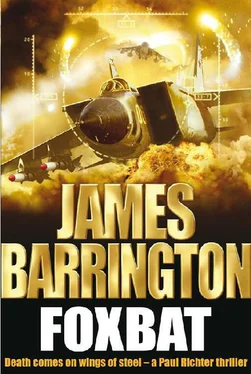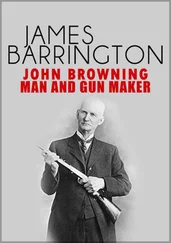‘Cobra Two, Vipers, switch to tactical on stud four.’
Richter switched frequency and checked in. ‘Cobra Two.’
‘Viper One.’
‘Viper Two.’
‘Roger, Cobra Two, Vipers. Stand by for rate one right turn onto one four zero in thirty seconds.’
‘Roger.’
‘Cobras, Vipers, turn now, now, now.’
As the Senior Pilot finished the sentence, all four aircraft swung gently to the right – a rate one turn being comparatively slow – and steadied on their new heading.
‘Cobras, Vipers, this is November Alpha.’
‘November Alpha, Cobra One, you’re loud and clear.’
‘Roger, Cobra Lead. You’re identified, Picture Alpha.’
Just under six minutes later the four Harriers throttled back and began a cruise descent. Passing twelve thousand feet, their Radar Warning Receivers showed the last of the North Korean surveillance radars beginning to lose contact, and by the time they reached eight thousand, the RAWs were silent.
‘Cobras, Vipers, stand by for a hard port turn onto north. Turn now, now, now.’
The moment they steadied, and passed five thousand feet in descent, Long ordered them to accelerate. Their comparatively slow speed and turn away from North Korea might have fooled the DPRK radar controllers, but none of them felt like betting on it. Their best weapons now were speed and surprise.
USS Enterprise , North Pacific Ocean
In the CIC, the radar operator called out to the captain. ‘Sir, those four contacts have cleared the east coast of South Korea, but they turned south-east and they’ve just started to descend.’
‘Of course they’re heading away from North Korea. They’re not stupid. If they’d turned towards the north, every radar station above the DMZ would have been tracking them, and feeding their coordinates to their SAM sites. Just keep watching. When they’re low enough, they’ll head north.’
Pyongyang, North Korea
‘Sir,’ the voice of the radar supervisor at the coastal radar station sounded calm and controlled, ‘those four aircraft are now heading away from us, and they’ve started descending. I suggest they’re probably just on a regular patrol, and therefore no direct threat to us.’
‘You could be right,’ Kim Yong-Su replied, ‘but your orders are perfectly clear. We still believe they may be planning an attack, so continue watching the areas out to the south and east, and inform me the moment you see any sign of them returning.’
USS Enterprise , North Pacific Ocean
‘You’re right, sir. They’ve turned north and increased speed. They’re not squawking Mode Charlie, but the Hawkeye estimates they’re down below two thousand feet.’
‘Got that,’ Rodgers said, and opened the intercom link to PriFly. ‘CAG, this is the Captain. What’s the state of play with the Hornets?’
‘Ready to go, sir. I’ve eight interceptors fully prepped, plus four fitted with refuelling pods that I’ll send off about forty minutes afterwards to pick them up on the way back.’
‘And the Prowlers?’
‘Two waiting on the bow catapults, sir, as you ordered.’
‘Very good. Launch the Prowlers and get the Hornets ready to follow.’
The deck was a scene of frantic but organized activity. The deck of any aircraft carrier at launch or recovery is one of the busiest, and certainly one of the most dangerous, places in the world. The Enterprise has four steam catapults, two on the foredeck and the other two amidships, and each would be used twice in quick succession to get the eight Super Hornet interceptors airborne.
But first the flight deck crews were going to get the two Prowlers into the air. The EA-6B has been around since the early 1970s, and is still the American Navy’s primary electronic attack aircraft, scheduled to be replaced in about 2010 by the EA-18G Growler, the electronic warfare version of the Super Hornet.
The Enterprise began a gentle turn as flight deck crew members checked that the Prowlers and their pilots were ready for launch. The moment the massive ship steadied, PriFly issued clearance to launch both aircraft. The blast deflector lifted behind the EA-6B on the starboard bow catapult and the pilot ran up the two Pratt and Whitney turbojets to full power. The J52 engines are non-afterburning, but are still powerful enough to give the Prowler a maximum speed of nearly six hundred miles an hour. The aircraft was heavy: although it wasn’t carrying drop tanks, it had a maximum load of four AGM-88 HARM anti-radar missiles and a single ALQ-99 TJS external pod.
Once the Prowler pilot indicated he was at full power, the steam catapult was triggered and the EA-6B shot along the deck. Thirty seconds later the second Prowler launched from the port catapult. Both aircraft took up a south-westerly heading and began climbing to their pre-briefed altitude of thirty-two thousand feet.
‘Climax, Zapper formation is switching to discrete.’
‘Zapper, Climax. Roger.’
The Prowler crews switched frequencies simultaneously.
‘Zapper Two.’
‘Two from One, roger. Break, break. Alpha Three, this is Zapper formation in the climb to three two zero heading two three five and squawking mode three alpha code four three two one.’
‘Zapper, Alpha Three, you’re identified. Maintain heading and call level at three two zero. Squawk standby. No traffic at present.’
‘Roger, Alpha Three.’
On launch, they were over five hundred miles from the Korean Peninsula, and at that height they were still well below the radar horizon of any DPRK surveillance sites.
The range/height calculation as it relates to radar coverage is simple enough: because of the curvature of the Earth, an aircraft at an altitude of five thousand feet will paint on a surveillance radar at a range of about fifty miles. To ensure the Prowlers stayed undetected, the Hawkeye would instruct them to begin descent before they reached the theoretical radar horizon, and set them up in a holding pattern at least one hundred miles from the east coast of the peninsula. From that point, they would be able to hit the first of the North Korean radar sites, assuming their assistance was needed, in less than twelve minutes.
Cobra and Viper formation, Sea of Japan
Flying in formation at well over four hundred miles an hour and less than five hundred feet above the surface of the sea, a pilot’s concentration has to be absolute. A split-second’s inattention and the Harrier could plunge into the waves or plough into another aircraft, and the four GR9s had widened their formation slightly to provide an added margin of safety.
‘Vipers, Cobra One. Stand by for split in thirty seconds.’
Richter took his eyes off the view through the windscreen for the bare few seconds it took to visually check his cockpit, then looked back.
‘Split now, now, now. Good hunting, Vipers.’
But as the tracks of the two pairs of Harriers diverged, the AEW Sea King radar controller passed his first traffic information message, and it wasn’t good news.
‘Cobras, Vipers, November Alpha. Picture Charlie. Launches from the airfields at T’ae’tan, Nuchonri, Kuupri, Wonsan, Toksan and Ŏrang. Multiple bandits, all tracking towards the east coast of the peninsula. Stand by for numbers and locations.’
‘Shit,’ Richter muttered. ‘That’s all we needed.’
USS Enterprise , North Pacific Ocean
The first Hornet taxied to the starboard bow catapult, expertly directed by a marshaller, and stopped with its nosewheel in precisely the right spot. The holdback – a steel bar designed to stop the aircraft moving forwards when the engines were run up to full power prior to launch – was attached to the rear of the nosewheel landing gear, and the front hitched to the catapult itself. Steam swirled around the men carrying out these tasks, giving the scene a somewhat surreal appearance.
Читать дальше












